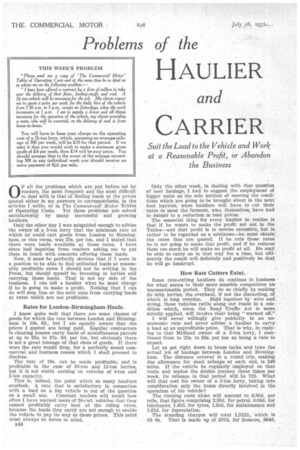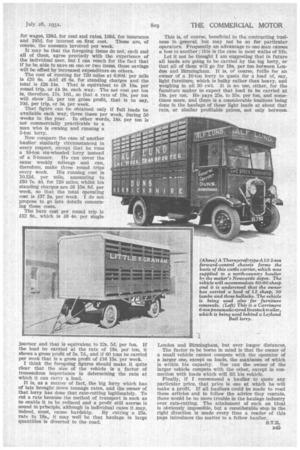Problems of the
Page 62

Page 63

If you've noticed an error in this article please click here to report it so we can fix it.
HAULIER
and
CARRIER
Suit the Load to the Vehicle and Work at a Reasonable Profit, or Abandon the Business
011 all the problems which are put before me by readers, the most frequent and the most difficult to deal with is that of finding loads at the prices quoted either in my answers to correspondents, in the articles I write, or in The Commercial Motor Tables of Operating Costs. Yet these problems are solved satisfactorily by many successful and growing hauliers.
, Only the other day I was misguided enough to advise the owner of a 5-ton lorry that the minimum rate at which he could cart goods from London to Birmingham, or vice versa, was 25s. per ton, and I stated that there were loads available at those rates. I have since had inqniries from readers asking me to put them in touch with concerns offering those loads.
Now, it must he perfectly obvious that if I were in a position to be able to find unlimited loads at reasonably profitable rates I should not be writing in the Press, but should myself be investing in lorries and carrying those loads. That is not my side of the business. I can tell a haulier what he must charge if he is going to make a profit Nothing that I can do will stop him or the next man from carrying loads at rates which are not profitable.
Rates for London-Eirmingharn Hauls.
I know quite well that there are some classes of goods for which the rate between London and Birmingham is 18s. 6d., but I am equally aware that the prices I quoted are being paid. Regular contractors to clearing houses carry loads of miscellaneous parcels at up to 35s. to 37s. fid. per ton, but obviously there is not a great tonnage of that class of goods. If there were the rate would drop, for a perfectly sound commercial and business reason which I shall proceed to disclose.
The rate of 18s. can be made profitable, and is profitable in the case of 10-ton and 12-ton lorries, but it is not worth earning on vehicles of 4-ton and 5-ton capacity.
This is, indeed, the point which so many hauliers overlook. A rate that is -satisfactory in connection with a load on a big vehicle is out of the question on a small one. Constant readers will recall how often I have warned users of 30-cwt. vehicles that they cannot profitably carry beet at the ruling rates, because the loads they carry are not enough to enable the vehicle to pay its way at those prices. This point must always be borne in mind.
1344 .
Only the other viieek, in dealing with that question of beet haulage, I had to suggest the employment of bigger units as the sole method of meeting the conditions which are going to be brought about in the next beet harvest, when hauliers will have to cut their rates to meet the farmers, who, themselves, have had to submit to a reduction in beet prices.
The essential thing for every haulier to realize is that if he wants to make the profit set out in the Tables—and that profit is in nowise excessive, but is rather to be regarded as a minimum—he must obtain the rates that are quoted. If he cuts those rates, he is not going to make that profit, and if he reduces' them too much he will make no profit at all. He may be able to carry on in that way for a time, but ulti-. mately the result will definitely and positively be that he will go bankrupt.
How Rate Gutters Exist.
Some rate-cutting hauliers do continue in business for what seems to their more sensible competitors an unconscionable period. They do so chiefly by making do with lorries, the overhaul, if not the discarding, of which is long overdue. Held together by wire and string, these vehicles rattle along our roads in a condition which, when the Road Traffic Act is more strictly applied, will involve their being " warned off." ,
I will never willingly, give publicity to an uneconomic rate and never advise a haulier to carry, a load at an unprofitable price. That is why, in replying to that Midland owner of a 5-ton lorry, I mentioned from to 25s. to 85s. per ton as being a rate to expect.
Let us get right dow-n to brass tacks and take the actual job of haulage between London and Birmingham. The distance covered in a round trip, making due allowance for dead mileage at each end, is 240 miles. If the vehicle be regularly employed on that route and makes the double journey three times per week, its mileage in that period will be 720. What will that cost the owner of a 5-ton lorry, taking into consideration only the items directly involved in the Operation of his vehicle?
The running costs alone will amount to, 6.80d. per mile, that figure comprising 2,36d. for petrol, 0.08d. for lubricants, 1.45d. for tyres, 1.30d. for maintenance and 1.61d. for depreciation.
The standing charges will total 1,512d., which is X6 6s. That is made up of 207d, for licences, 864d. for wages, 138th for rent and rates, 108d. for insurance and 195d. for interest on first cost. These are, of course, the amounts involved per week.
It may be that the foregoing items do not, each and all of them, agree precisely with the experience of the individual user, but I can vouch for the fact that if he be able to save on one or two items, those savings will be offset by increased expenditure on others.
The cost of running for 720 miles at 6.80d. per mile is £20 8s. Add £6 6s. for standing charges and the total is £26 14s. That is equivalent to ES 18s. per round trip, or £4 9s. each way. The net cost per ton is, therefore, 17s. 10d., so that a rate of 18s. per ton will show 2d. per ton gross profit, that is to say, 10th per trip, or 5s. per week.
That figure can 'be obtained only if full loads be available each way, three times per week, during 50 weeks in the year. In other words, 18s. per ton is not commercially practicable to a man who is owning and running a 5-ton lorry.
Now compare the case of another haulier similarly circumstanced in every respect, except that he runs a 10-ton six-wheeled lorry instead of a 5-tonner. He can cover the same weekly mileage and can, therefore, make three round trips every week. His running cost is 10.12d. per mile, amounting to £30 7s. 4d. for 720 miles, whilst his standing charges are £6 15s. 8th per week, so that the total operating cost is £37 3s. per week. 1 do not propose to go into details concerning these costs.
The bare cost per round trip is £12 8s., which is 16 4s. per single journey and that is equivalent to 12s. 5d. per ton. If the load be carried at the rate of 18s. per ton, it shows a gross profit of 5s. 7d., and if 60 tons be carried per week that is a gross profit of £16 15s. per week.
I think the foregoing figures should make it quite clear that the size of the vehicle is a factor of tremendous importance in determining the rate at which it can carry a load.
It is, as a matter of fact, the big lorry which has of late brought down tonnage rates, and the owner of that lorry has done that rate-cutting legitimately. To cut a rate because the method of transport is such as to enable it to be reduced and a profit still accrue is sound in principle, although in individual cases it may, indeed, must, cause hardship. By cutting a 25s. rate to 18s., it may well be that haulage in large quantities is diverted to the road. This is, of course, beneficial to the contracting business in general, but may not be so for particular operators. Frequently an advantage to one man causes a loss to another ; this is the case in most walks of life.
Let it not be thought I am suggesting that in future all loads are going to be carried by the big lorry, or that all of them will go for 18s. per ton between London and Birmingham. It is, of course, futile for an owner of a 10-ton lorry to quote for a load of, say, light furniture, which is bulky rather than heavy, and weighing in all 30 cwt. It is no use, either, for the furniture maker to expect that load to be carried at 18s. per ton. He pays 25s. to 35s. per ton, and sometimes wore, and there is a considerable business being done in the haulage of these light loads at about that rate, or similar profitable prices, not only between London and Birmingham, but over longer distances.
The factor to be borne in mind is that the owner of a small vehicle cannot compete with the operator of a larger one, except on loads, the maximum of which is within his capacity. Nor can the owner of the larger vehicle compete with the other, except in connection with loads which will fill his vehicle.
Finally, if I recommend a haulier to quote any particular price, that price is one at which he will make a profit. If all hauliers could be made to read these articles and to follow the advice they contain, there would be no more trouble in the haulage industry over rate-cutting. The attainment of such an ideal is obviously impossible, but a considerable step in the right direction is made every time a reader of this page introduces the matter to a fellow haulier.




































































































